Microwaves are an energy efficient way to cook food at home, but they do come with some safety issues, and far too many are ending up in landfills. Here are our top picks for long lasting, safe, and climate friendly microwaves.
Table of Contents
Microwave ovens offer one of the most energy-efficient ways to cook food, but like any cooking method, there are some safety issues to consider. I’ve already written about microwave ovens and radiation, including a look at who regulates microwave ovens and how to use a microwave oven safely. This time, I discuss known safety issues with microwaves, the brands you might want to avoid, and the safest microwaves for 2024.
Most countertop microwaves range from around 0.5 cubic feet (which can fit most 10-inch dinner plates) to just over 2 cubic feet (which may accommodate plates with a 15-inch diameter).
For most homes, a microwave with 1-2 cu. ft. is more than enough.
The more power and more capacity, the more resources and electricity your microwave will use and the more space it takes up in your kitchen.
Curious about how we rate products? Click here to view our methodology, which at its core, is about voting with our dollars to fight climate change.
Environmental impact
At Leaf Score we’re concerned both with safety and with the environment. As such, it’s maddening that the average lifespan of a microwave has dropped by nearly seven years over the last 20 years – from more than a decade to six to eight years – according to a report out of the University of Manchester, UK.
The report projected that by 2020, 16 million microwaves would be discarded each year and barely any of the embedded value in these machines will be reclaimed.
Consumers now tend to buy new appliances before the existing ones reach the end of their useful life as electronic goods have become fashionable and ‘status’ items. As a result, discarded electrical equipment, such as microwaves, is one of the fastest growing waste streams worldwide.’
Dr Alejandro Gallego Schmid
The same report also noted that microwave use in the European Union is responsible for the equivalent carbon dioxide emissions of two coal-powered power plants every year. The best way to reduce such emissions is to use microwaves more effectively, including choosing shorter cooking times rather than blasting food unnecessarily.
So, consider safety, reliability, and performance when choosing your new microwave, and make sure to take your old microwave to a local recycling depot where possible.
Microwave Safety
The National Fire Prevention Association (NFPA) reported 6,700 average house fires annually caused by microwave ovens between 2011 and 2015 alone. Every year, microwave fires led to 10 deaths, 120 injuries, and $33 million in property damage.
Per fire, the average financial loss was $4,900.
While researching this piece for Leaf Score, I unplugged the microwave languishing in the corner of my kitchen.
Why?
For one, I didn’t use the microwave more than once or twice a month, so it was wasting energy.
Secondly, the reports of self-starting microwaves made me look a little differently at this machine that was taking up space in my rental apartment.
Spending a little more on a better quality microwave and some batteries for your smoke alarm, plus a Safe T Sensor, seems like a bargain in comparison.
Accidents happen and even proper use of the microwave can cause a fire. Microwaves can sometime ‘arc’, meaning that it sparks and ignites plastic inside the appliance, triggering a fire.
Consider installing the Safe T Sensor. This plugs into your electrical outlet and your microwave plugs into the sensor, allowing the sensor to interrupt power to the microwave oven at the first sign of smoke.
If you’re concerned about the risk of self-starts, arcing, and sparking, also consider unplugging the microwave whenever it’s not in use.
Additionally, never let the microwave run unattended (as with any cooking appliance).
Other ways to stay safe include:
- Registering your microwave with the manufacturer – find out fast about recalls or safety issues
- Knowing where the unit is plugged in and how to cut the electricity supply quickly
- Keeping a multipurpose fire extinguisher close by
- Making sure everyone who might use it knows how to use the microwave (and fire extinguisher!) safely.
Broken controls and problems closing the microwave door can lead to increased exposure to microwaves, a higher risk of damage to the microwave and other possible safety issues. Microwaves notorious for these issues also suffer from poor longevity, which means they have a greater environmental impact.
Finally, if you do notice any malfunctions, contact the manufacturer and report it to the Consumer Product Safety Commission (SaferProducts.gov or CPSC.gov or 800-638-2772).
Free eBook: Simple Steps to a Greener Home
Concerned about climate change? Learn actionable tips for making each room in your home greener.
"*" indicates required fields

Choosing a Safe Microwave
Microwaves are typically a lot cheaper than an oven range, dishwasher, or refrigerator, but that doesn’t mean you shouldn’t think hard about where to spend your money. Getting a subpar microwave may mean you have to tear it out from over your range, get it repaired, or even replace it after a short time. This isn’t good for you bank balance or for the environment, even if you do take your old microwave to be recycled.
To find a reliable microwave that performs well, and meets or exceeds safety standards, start with the following steps:
- Check for the safety certificates that come with most microwaves
- Look for safety recalls as listed by the Consumer Product Safety Commission (CPSC)
- Run a quick search online for any known safety issues with any model you’re considering
- Look specifically for reviews mentioning issues with door seals and locking, or other safety concerns.
Top tip – if you buy or acquire a microwave secondhand, check the CPSC for any safety recalls!
My other top tip is to look for a microwave with a ‘delay start’ feature. This is a way of ‘safety-hacking’ your microwave to get it to start after you’ve already stepped away from the unit.
Free eBook: Simple Steps to a Greener Home
Concerned about climate change? Learn actionable tips for making each room in your home greener.
"*" indicates required fields

The Best Microwave Brands
I’ve been researching microwaves for years now and have come to the conclusion that, with a few important exceptions, there’s very little to distinguish any particular well-known brand from another. (See below for brands to avoid.)
Most countertop microwaves are built by the same manufacturer (Midea) at the same facility. They mostly comprise the same set of parts, just with different finishes and some variation in functions, but not much.
That said, almost all brands have their ardent fans and their passionate detractors. Looking at customer reviews, research from Consumer Reports, Wirecutter, Ethical Consumer, and a range of other professional review sites suggests the following brands are consistently worth your attention:
| Panasonic | Many happy customers over many years | Good range of sizes |
| Toshiba | Many happy customers over many years | Specializes in compact microwaves |
| Black & Decker | A top choice for its environmental policies | Offers matching small appliances like kettles, toasters, etc., and great for lawn mowers and power tools! |
| Miele | A top choice for business ethics | high-end brand (with high-end prices) |
| Frigidaire, Hotpoint, Kenmore | Great for OTR microwaves | Reliable, and good performance |
| Ikea | Great for OTR microwaves | Ever-improving approach to sustainability and environmental awareness |
| Avanti | Best for countertop models | Good reliability and performance |
| Farberware | Best for countertop models | Good reliability and performance |
Our top picks
- Excellent controls – easy to read, with great functions
- Attractive (for a microwave)
- Mute sound option
- Automatic reheating
- Handle door (not button)
- Removable turntable (for easy cleaning)
- Smart humidity sensor
- 12 auto menus
- Easy to clean
- A little bit deeper and taller than the Panasonic
- Slightly smaller turntable than the Panasonic (but big enough for a 12-inch pizza)
At a glance:
Capacity: 1.2 cu. ft.
Dimensions: 17.1 inches deep, 19.2 inches wide, 12.8 inches high
Turntable size: 12.4 inch
Wattage: 1100 W
The Toshiba EM131A5C is a midsize countertop microwave that stands out from the crowd with a handful of extra features and arguably a better aesthetic.
You can get this microwave in silver or black and it has a useful door handle instead of a button, making it more accessible for some users. The large interior easily fits a 12-inch pizza and is easy to clean.
Toshiba designs its microwaves so that the fan continues to operate even after the magnetron has turned off. Don’t be spooked. This doesn’t mean the microwave is still running even after you’ve opened the door. Rather than being a safety concern, this is a great safety feature to help prevent the microwave overheating and incurring damage.
According to Toshiba, the fan continues to run in proportion to cooking time. So, if you microwave something for 10 seconds, the fan will continue to run for another 30 seconds after microwaving stops. For more than 10 minutes of cooking time, the fan will run for another 3 minutes to cool down the unit.
- Impressive capacity in small space
- 7 preset autocook settings
- 13.4 inch diameter turntable
- +30 second cooktime feature
- Keep warm feature
- Child safety lock
- Delay start and timer.
- Discontinued, so limited availability
At a glance:
Capacity: 1.3 cu. ft.
Dimensions: 16.63 inches deep, 20.44 inches wide, 12.38 inches high
Turntable size: 13.4 inch
Wattage: 1100 W
Panasonic’s 1.3 cu. ft. microwave is a great choice for mid-size families and couples. The NN-SU696S model has all the safety features of the larger 2.2 cu. ft. model with just a little less power (1100 W) and a little less capacity (1.3 cu. ft.).
The Panasonic takes up a lot less counter space than models with similar capacity and power, and even a little less than a lower powered, smaller capacity competitor (see Toshiba above and Farberware below). It also performs to a high level, offers great reliability, and has the same Genius Sensor as the larger model, meaning you’re far less likely to accidentally undercook, overcook or set fire to your food.
- Compact microwave for smaller spaces
- More affordable
- Great functions
- Easy to read (and use) controls
- Mute option
- Power Saver mode (turns off display when not in use)
- Stainless steel or black stainless steel options
- 10 power levels
- Lighter than many models (easy to mount or put on a shelf)
- Small, best suited for dorms or offices
- No delay start function
At a glance:
Capacity: 0.9 cu. ft.
Dimensions: 15.9 inches deep, 19.2 inches wide, 11.5 inches high
Turntable size: 10.6 inch
Wattage: 900 W
This smaller Toshiba microwave offers almost all the same functions as its larger peer just in a more compact space. As with the larger model, this one has an option to mute all sounds, as well as a Power Saver mode to turn off the digital display.
This fabulous little microwave has a large, easy to use door handle and clear and responsive touch controls. It is also easy to clean and has a control lock function for safety.
This microwave is a really good choice for single folks and anyone who doesn’t need a high-powered, high-capacity microwave but wants a reliable, well-designed model. Toshiba also has a reputation for excellent customer care, so if anything does go wrong, chances are it can get fixed.
Toshiba has had an in-house organization to promote corporate social responsibility since 20023. This has helped Toshiba become an industry leader in sustainability, with company activities better aligned with the Sustainable Development Goals (SDGs) than many other electronics brands. In 2021, Toshiba established a dedicated Sustainability Management Division and it publishes detailed annual environmental reports containing meaningful information.
Toshiba has a goal of reducing scope 1 and 2 company greenhouse gas emissions by 70% throughout its value chain by 2030, against 2019, and to achieve carbon neutrality by 2050. It also has a goal of a 100% reduction (2019 to 2030) in business activity-related GHGs.
This small microwave only weighs 27.3 lbs, making it a breeze to relocate or mount in your kitchen. The buttons are also large and labelled clearly, making it much easier to use in low light or if your eyesight isn’t great.
I also like the care and attention paid to packaging the microwave to avoid damage in transit.
- Delay start function
- Impressive interior capacity in a small countertop footprint
- Child safety lock
- Turbo defrost
- Quick minute timer and preset menu items
- Easy power adjustment
- Can’t quite fit a 12-inch pizza/dish
At a glance:
Capacity: 0.8 cu. ft.
Dimensions: inches deep, inches wide, inches high
Turntable size: 11.25 inch
Wattage: 950 W
In danger of sounding like a broken record, one of the best options for a safe microwave for dorm rooms, small spaces, the office, or those who mainly use their microwave for mug cakes is… a Panasonic. The NN-SD372S boasts the Genius Sensor and inverter technology that make this brand a go-to for microwave ovens in any size.
This one features the same delay start function as the larger models. As such, you can set your cook-time and then step away from the microwave to almost entirely eliminate the risk of radiation exposure.
And, again, Panasonic devote more space to the internal capacity of the microwave than to the electronics, so this countertop microwave boasts an 11.25-inch turntable but takes up a lot less space than the similarly powered and sized Toshiba and almost the same space as the much lower powered Black & Decker.
Free eBook: Simple Steps to a Greener Home
Concerned about climate change? Learn actionable tips for making each room in your home greener.
"*" indicates required fields

- Fast and even heating
- Easy to use
- Good owner satisfaction
- Large turntable in a small footprint
- A little noisier than competitors on High heat
- No handle
At a glance:
Capacity: 1.2 cu. ft.
Dimensions: 15.81 inches deep, 20.69 inches wide, 12.25 inches high
Turntable size: 13.4 inch
Wattage: 1200 W
The Panasonic NN-SN686S offers some quick use functions that make this microwave a sure fire hit for dorm rooms and offices. The Sensor Reheat button makes lunchtime leftovers easier than ever, and the inverter technology means the microwave can adjust power levels with precision, unlike conventional microwaves which intermittently blast food with heat and then turn off the heating element before blasting food again.
The result of inverter technology is faster, more even heating (and less nutrient loss from food), which Panasonic seems to excel at.
- 10 power levels
- 6 preset cooking settings
- Can save favorite cooking programs for quick use
- +30 seconds button
- 1-year warranty
- Keypad lock for safety
- Simple, clear, and easy to use control panel
- Not an inverter model (slower, less even heating)
- Not as many functions as the same size Panasonic and Toshiba
- No smart sensor
At a glance:
Capacity: 1.1 cu. ft.
Dimensions: 16.91 inches deep, 20.2 inches wide, 12 inches high
Turntable size: 12.4 inch
Wattage: 1000 W
The Farberware Classic FMO11AHTPLB is a mid-size microwave made by a company with a strong reputation for reliability and performance.
It offers 1-6-minute express cook buttons and can defrost based on time or weight. The handy multi-stage cooking option lets you program your cooking without needing to interrupt and reset.
The rotating glass turntable is removable for easy cleaning. This is also handy for times when rotation isn’t required or cookware won’t quite fit if rotated (such as a glass lasagna pan).
The reliability, clear labelling, and ease of use, as well as the keypad lock make this microwave a good choice for safety. However, the Panasonic model that takes up around the same amount of counter space offers far more safety features and better performance and all for the same price for the stainless steel model.
If you do a lot of microwave cooking and tend to over- or undercook your food in the microwave, consider spending an extra $17 or so to get the higher capacity Farberware below, with inverter technology and Smart Sensor.
- Large turntable
- More affordable than Toshiba and Panasonic
- Inverter technology
- Smart Sensor
- Energy saver mode
- 1-3 minute instant start function
- +30 seconds button
- 10 power control levels
- 6 one-touch preset cooking buttons for popular foods.
- Defrost function and a memory function
- Child safety lock function
- Easy to clean
- Much wider and deeper even than models with more internal capacity
- No delay start function
At a glance:
Capacity: 1.6 cu. ft.
Dimensions: 19.17 inches deep, 21.77 inches wide, 12.84 inches high
Turntable size: 13.6 inch
Wattage: 1100 W
Farberware also offers a slightly larger microwave with inverter technology for continuous energy output and Smart Sensor technology. This is a great option if you do a lot of microwave cooking and could do with a helping hand to prevent overcooking or undercooking food.
This Farberware microwave has an energy saver mode for when the microwave isn’t in use and a memory function, so you can save your favorite cooking settings for ease of use. There’s also a multi-stage function to adjust cooking level mid-cycle without any need for you to reprogram.
The LED display is clear and buttons are clearly labeled, the interior is easy to keep clean, meaning your microwave will likely work better for longer.
It’s a shame that this microwave doesn’t have a delay start feature, unlike the Panasonics, and it’s also worth noting that this model takes up a lot of counterspace, especially compared to the streamlined Panasonic microwaves. So, if space is at a premium, don’t try to squeeze in the Farberware. You may end up obstructing the vents, causing a safety issue. Instead, get a Panasonic!
- Incredibly small footprint and lightweight
- Brand has good environmental policies
- Affordable
- Child safety lock
- 10 power settings
- Clock and kitchen timer
- 30 seconds express cooking option
- 6 pre-programmed settings
- removable turntable
- Much lower power than other models
- Small turntable
- Very beepy with no option to mute
- Not very heavy, so may move if pushed hard
At a glance:
Capacity: 0.7 cu. ft.
Dimensions: 13 inches deep, 17.3 inches wide, 10.2 inches high
Turntable size: 10-inch
Wattage: 700 W
Black+Decker’s EM720CB7 Digital Microwave Oven is an affordable and high-performing microwave from a brand with excellent environmental policies and a strong reputation. This 0.7 cu. ft. capacity microwave offers 700 W of power.
This microwave has a push button door, making access easy, and also features a large LED digital display and clearly labeled control panel. The interior light makes it easy to see how your food is doing, and the removable 10 inch turntable offers flexibility if you need to use rectangular cookware that wouldn’t work with the rotation feature.
This microwave also weighs just 25.4 pounds and is very small, making it super easy to relocate and to mount to keep counter space clear. A dash smaller than the Toshiba, the Black+Decker also has a little less power and a little less capacity. Both seem to perform well, but the Black+Decker suffers from its lack of heft; the microwave may move when you push the button to open the door. This is easily cured by putting a rubber shelf liner beneath the unit or cutting up a liner to put under the oven’s feet.
The Black+Decker is affordable and ships free in the US.
One final thing differentiating the Black+Decker from the Toshiba is its noisiness.
Both microwaves operate quite quietly in terms of the microwave and fan, but the Black+Decker is a chirpy machine, with lots of beeps that can’t be disabled. The Toshiba beeps a lot less in general and has the option of a silent mode.
In terms of safety, beeps can be very helpful, but for the noise sensitive, the Toshiba definitely wins.
Free eBook: Simple Steps to a Greener Home
Concerned about climate change? Learn actionable tips for making each room in your home greener.
"*" indicates required fields

Microwaves to Avoid
Certain brands of microwaves seem to fare less well than others. Here’s a quick summary of ones I think are worth avoiding.
| Electrolux OTR microwaves | seem to develop more problems than most other brands, such as doors not closing properly and controls locking up | don’t perform quite as well, heating food unevenly for example |
| Samsung OTR | many reports of issues with controls not working properly | |
| Jenn-Air | don’t heat food evenly | |
| Electrolux countertop microwaves | many reports of poor performance | |
| RCA countertop microwaves | many reports of poor performance | |
| Frigidaire countertop microwaves | many reports of poor performance | |
| Whirlpool | performance and reliability issues | recalls for catching fire (brand has since implemented new safety technology) |
The KitchenAid KHMS155LSS, made by Whirlpool, was at the center of a firestorm (literally) just over a decade ago after multiple reports surfaced of this microwave turning itself on and sparking fires.
Final thoughts
Finally, while I often recommend looking for hand-me-downs or thrift store finds to keep your environmental impact low, this may not be the best choice when it comes to microwave ovens.
If you’re considering purchasing (or you inherit) a secondhand microwave, make sure it’s now been subject to a safety recall and is in good working order (no rust, scorch marks, or warping, for instance). Checking the CPSC list is your best bet. You can also check SaferProducts.gov for individual consumer reports of incidents involving microwaves.
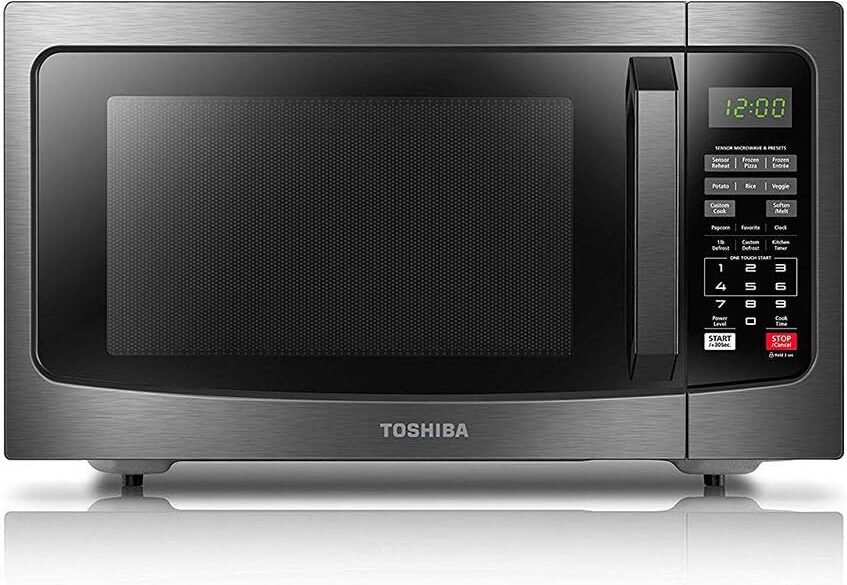
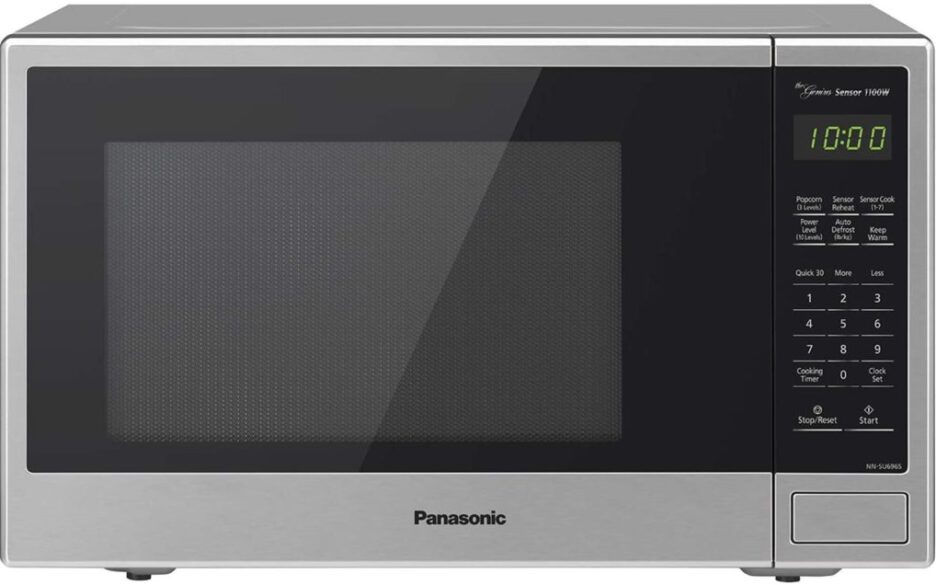
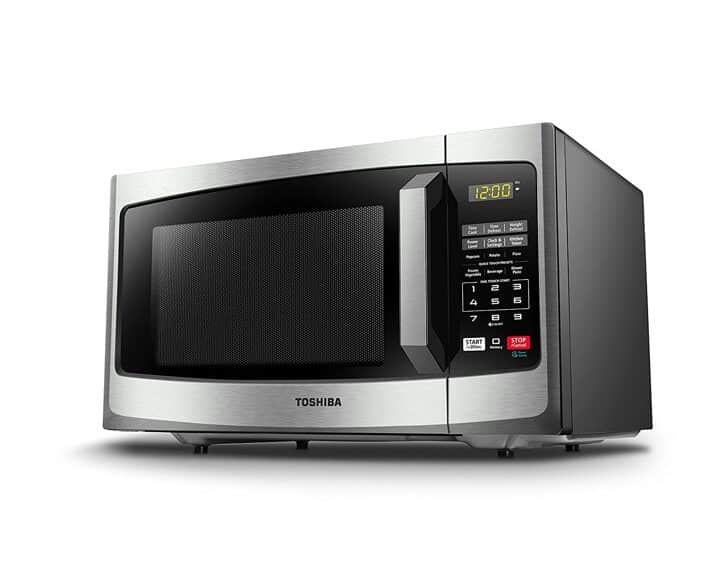
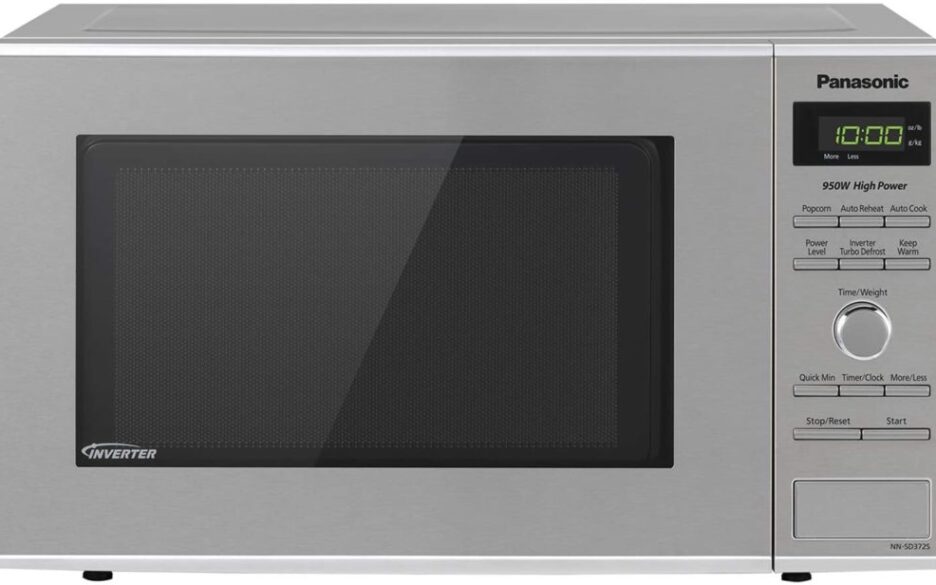
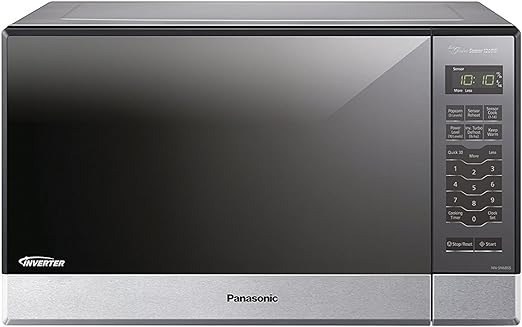
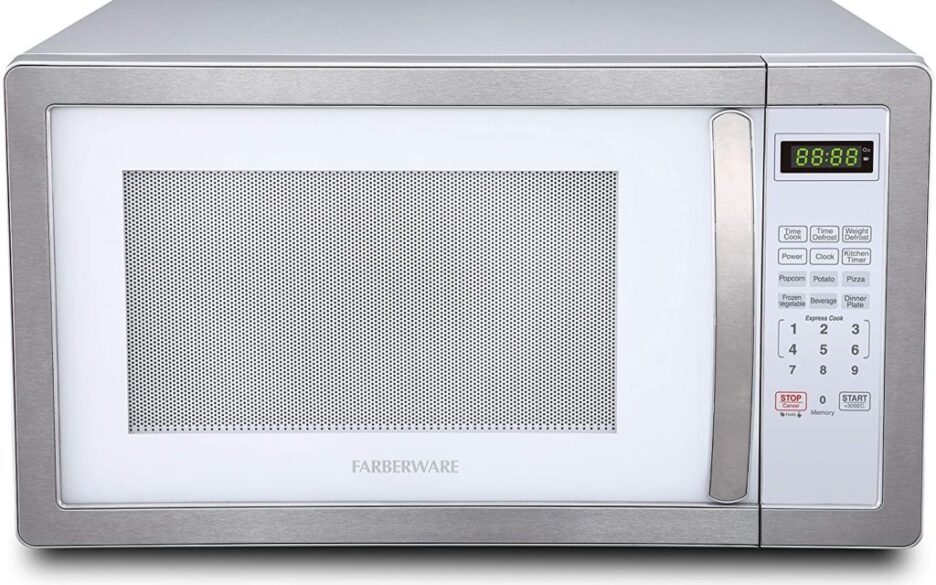
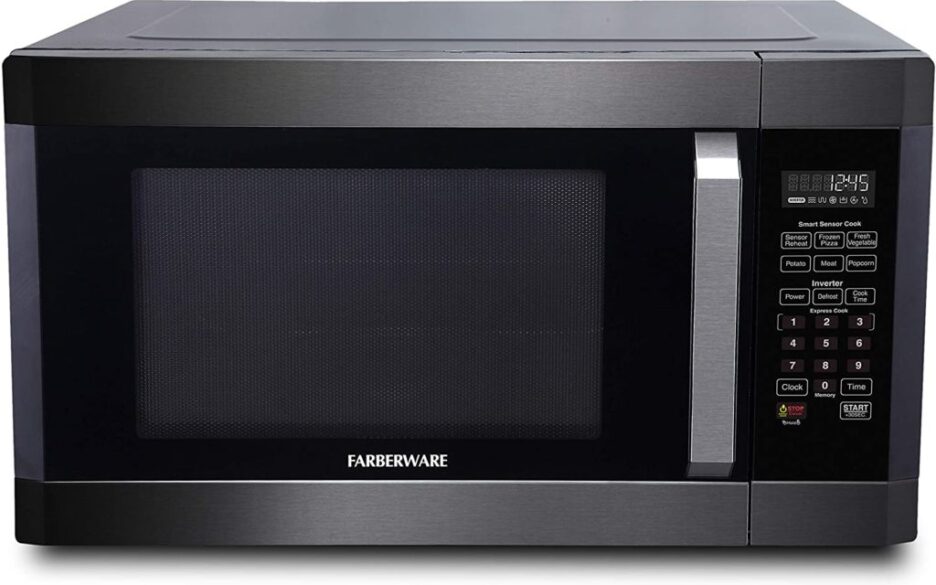
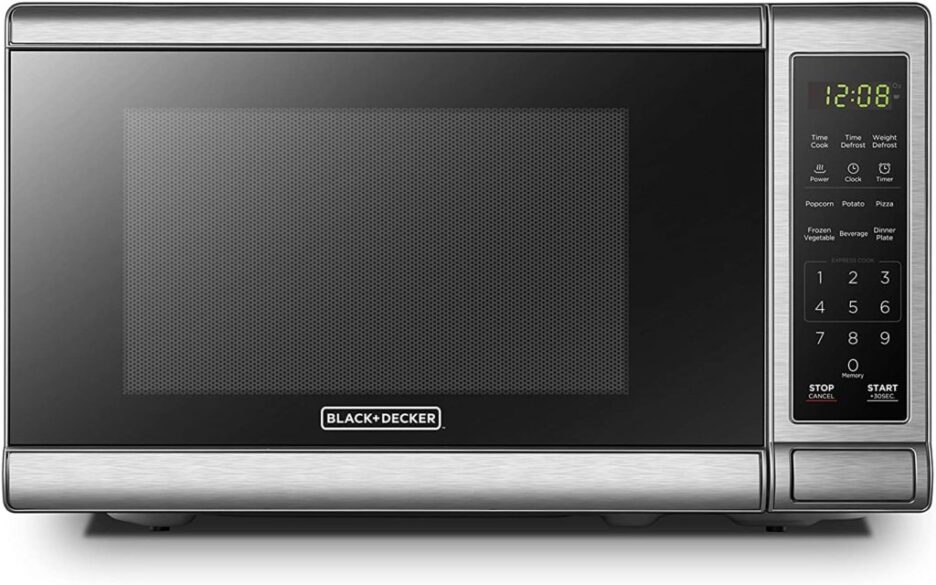
May 24
Hi I like your site and appreciate the research ideas. I have a question… before I saw your site…I purchased a Panasonic NNSC668S 1200 Watt counter top microwave. You mention a medium size Panasonic, but the NN number is different. Would the one I bought…still in the box….be a 4 out of 5 leaf option?
It also says inverter technology…. what is that?
Thank you,
Mary Ann
Hi Mary Ann,
Apologies for the late reply!
It looks like the model you have is almost exactly the same as the NN-SU696S I’ve reviewed here. The key differences seem to be in the power, with the SU696S offering 1100 Watts and the one you have (the SC668S) offering 1200 Watts, and the Genius Sensor technology in the SU696S. The power isn’t a major difference, so if you got a good deal on yours, keep it and enjoy the extra bit of power! If you like the idea of the Genius Sensor technology though, trading your current model in for the slightly more expensive SU696S might be worth it. The Genius Sensor helps gauge when food is properly cooked or defrosted (by measuring steam output) and minimizes guesswork by modulating power and cooking time. This helps prevent overcooking or superheating.
As for inverter technology, I go into a bit more detail about this in the review for the SN966S above. Inverter microwaves put out a constant stream of energy rather than pulsing on-off at lower temperatures. The benefit is more even cooking, especially for foods that need to simmer or melt slowly..
Hope this helps!
Leigh
Hi, thanks for your article- very informative. I have a question. I saw on Panasonic’s website that the model you gave 5 out of 5 leaves under the best mid-sized microwaves has a proposition-65 warning. Do all microwaves have that warning? Are there safer models that do not have this warning? Here’s the link that shows the warning for this particular model:
https://shop.panasonic.com/microwave-and-kitchen/microwave-ovens/countertop-microwave-ovens/NN-SU696S.html
I would greatly appreciate your thoughts on this issue. Many thanks!
Hi Lucy,
Great question!
Most electronic goods will carry that Prop 65 warning because there could be heavy metals in various parts of the product (but not usually in any part that is exposed). A Prop 65 warning generally means either that the company has assessed their product and determined that exposure to the restricted substance exceeds the ‘no significant risk level’ OR that they haven’t assessed the potential exposure but don’t want to fall foul of California law.
It’s highly likely that the reason for the Prop 65 warning is because Panasonic are trying to avoid potentially costly penalties for not complying with the regulation. Many companies take this approach out of an abundance of caution, especially because the Prop 65 chemicals list doesn’t provide exposure limits for all the substances listed, which makes things a bit tricky for a business wanting to stay in compliance.
I don’t recall coming across any microwaves without that Prop 65 warning when researching this piece, nor would I expect to unless the company chose not to sell their product in California.
Hope this helps!
Leigh
The Prop65 warnings are frustrating at best. They provide no practical information. If they are going to be used, the specific materials that are harm causing and what contact or interaction will cause said harm should be published. Just being warned that I can get cancer if I use a product is not helpful if all products carry the warning. That just indicates that there are not safe products, which is a bigger problem. It solves absolutely nothing for consumers.
Leigh, the other specs lists say the turntable for the Panasonic microwave NN SU696S is 12.4”, not your cited 13.4.
I’d settled on this oven based on your article, but now I’m not so sure. I was looking for a safe, reliable 2.2 Cu ft but was impressed by your review of this 1.3. My dead Kenmore is 2.2 Cu ft with only a 12” turntable. I’m not able to visualize what the difference will be in actuality. And I can’t go to stores because of Coronavirus fears. Maybe I measured incorrectly, but I have smaller numbers for the interior of the Kenmore than you or someone cited for the Panasonic yet the cubic feet of the Kenmore is larger???
Hi Toni,
Thanks for pointing out my typo! I’ve corrected the 13.4 to 12.4, having double-checked the specifications with Panasonic. Sorry for the confusion I caused there.
As for the difference in cubic capacity, I suspect this might be a matter of usable space vs. bigger footprint. Some microwaves are just bulkier in general, while others make really efficient use of materials and have a lower overall size but a bigger internal cavity relative to overall size. Without knowing the model of your Kenmore, it’s hard for me to compare it with the Panasonic here.
Again, my apologies for the typo (and thanks for spotting it and letting me know!). I checked all the other internal and external measurements too, so you could always take measurements of your current Kenmore and make a direct comparison yourself to see if the Panasonic will fit your needs (and cookware!).
Hope this helps,
Leigh
Thanks, Leigh. So I still haven’t decided what Cu ft I want.
Did you know some rating people are downgrading this oven? Tech Gear for one. I don’t remember what their reasons were.
Hi there! Thank you so much for all the information regarding microwaves. I notices, however, that there is no mention of Breville brand microwaves and their safety. Would you happen to have any information/reviews of their microwaves?
Hi!! Thank you so much for your articles and research! I read your linked article and tested my microwave and my sisters with the calling method and they’ve both failed. Will the microwaves listed in this article pass the phone call test for radiation leakage?
Hi Leigh, thank you for this informative article. I’m wondering what your thoughts are on the Galanz 3 in 1 – microwave, convection, air fryer. Model #GSWWD09S1A09A. I didn’t know these existed and I’m wondering if it’s worth going with a company I don’t know built in China. Do any of the more known companies make something like this?
Thanks in advance,
I have a question. I have a Panasonic Microwave Model # NN-SN965S and there seems to be some microwave leakage. It seems to affect our TV and its reception from the Genie attachment to the tv causing it to lose connection. I tested the affects using the technique of putting a phone into the microwave to see if I can call the phone. According to the test I should not be able to call the phone but it does with no problem.
Should I be concerned about this. I don’t seem to be able to contact anyone at Panasonic.
Hi Tim,
I don’t see any product recalls or known issues with this model, but this does sound strange. I would check to ensure the door is properly aligned and is closing correctly, and if there is any corrosion or other obvious faults in the interior of the microwaves that might be causing leakage. You might also consider taking the microwave into a local repair store to get it checked out, just for safety.
All the best,
Leigh
Thank you for your efforts, Leigh! I just discovered your site, and look forward to doing more exploration in it. I too am concerned about food-prep safety, and my search has led me to find out that many brands of microwave are produced by the same handful of manufacturers. Apparently Panasonic is one of these! I have found out so far that the concerns that microwave repairmen consider are whether all of the components inside, including the power cord, match up with the intended amperage of the unit so as to not overheat and burn out or burn up, or whether cheap plastic components mounted too close to the heat-producing elements (like the magnetron) will melt to start fires. I was told that, for home models, expecting more than 1000 watts is unrealistic, since most consumer units aren’t designed to safely handle more.
One thing that I have considered is getting a small commercial model, about 1cf, since they tend to have better shielding for all-day exposure in little food stalls where there is no place to go to get away from it. Both Panasonic and Amana, as well as several others, offer 1000 watt units with standard house-current wall plugs, and the Amanas advertise a small 13-amp power demand. While they are repairable, some may not offer a warranty for home usage even though they are ETL-listed. Amana’s RCS series, particularly the RCS10DS and RCS10TS are supposed to stand up to 50 uses per day in an average self-serve food area or prep kitchen. I’m not up as much on some other brands that are out there yet, like the Solwave and Summit, but I’m trying to be an informed consumer, because the better-made commercial units are pricey. I have found out that Menumaster is also Amana, but even though they are under Whirlpool corp., I don’t know who makes their commercial line for them yet. They all seem to look pretty Plain Jane, but at least they seem like a safer choice. I like your idea of using a gadget with a circuit breaker, though.